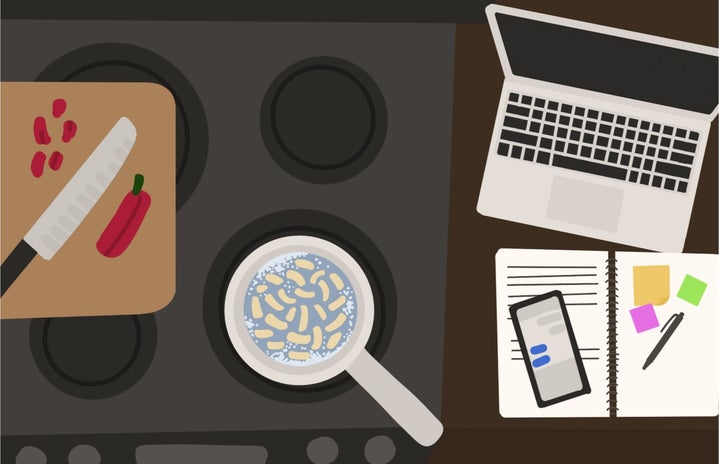I’ll be the first to admit – while dining halls typically try their best to have extensive options, eating at the same place three meals a day, seven days a week gets old. Learning to cook for yourself is not only an important life skill, but it is also super helpful throughout college to save money and avoid the inevitable dining hall exhaustion.
Cooking in a small dorm with limited resources is undoubtedly difficult, so finding ways to be creative is beyond important. These are things that I’ve learned throughout my first semester in college. I have always loved cooking, especially in the past year and a half, as I’ve spent so much time stuck at home. So, when I came to college, I was hell-bent on figuring out how to continue creating delicious food from the comfort of my own dorm, and I’m here to teach you how to do the same.
Appliances
Every university has different rules with appliances. Personally, I love an air fryer, and I am so lucky to be allowed to have one (when used in the dorm kitchen). If you’re allowed to keep an air fryer, that would be my number one recommendation to invest in. They’re quick and easy and can cook a wide range of foods–from poultry to fresh vegetables. Microwaves, which are allowed in most dorms, are also an incredibly helpful appliance, especially when you know how to use their settings. Most microwaves are automatically set to 100% power, which allows for the quick-cooking that we’re all used to. However, changing the power level opens up a huge range of cooking possibilities. For example, 50% power level mimics slow-cooking when the timer is increased, and 30% power level can be used for simmering. You can check out this website to see all of the power levels. A surprising number of foods can be prepared in a microwave–just search for recipes online. Here are a few basics:
Ingredients
Space is limited in a dorm. You can’t always keep Costco-sized bags of food and a whole kitchen’s worth of ingredients. So, find a few of your essentials to keep on hand 24/7, and go from there. For me, this is a salt grinder, soy sauce, hot sauce, minced garlic, tofu, and pasta, but it looks different for everyone. With this list of ingredients alone, I can make a delicious meal: tofu in pasta with a spicy garlic soy sauce. These are general ingredients–things that may be boring alone but can combine with numerous ingredients to make delicious meals. Once you have these core ingredients on hand, you can be creative to build more meals.
I don’t mean to sound like your mother, but don’t forget about fresh vegetables as well. College is an infamous time for providing our bodies with overly processed, non-fresh foods. Do your body a favor, and feed it something fresh every once in a while. It’s not as expensive as many may think. For example, I bought myself a single serving of green beans from the grocery store for 23 cents. I know…vegetables can be boring, but that’s why you have your staple ingredients on hand. Toss some green beans in a little bit of hot sauce, salt, and garlic, and you have cooked yourself an easy, healthy, and most importantly, delicious snack.
Tools
I came to college with a lot of cooking utensils and have really only used a few of them. Besides the standard plates, bowls, and silverware, having the right tools can make dorm cooking significantly easier. First and foremost, get a good knife (just don’t keep it out in the open). With the knife, you have to get a cutting board. You don’t need to splurge on this, so just get a cheap plastic one. If you plan on cooking vegetables, salad, or even baking, get a medium to large mixing bowl (it’s pretty easy to store if you keep smaller objects inside of it). I also get a lot of use out of my Pyrex glass containers. They’re microwave and oven safe, so you can cook with them, and they come with lids, so you can store your leftovers.
Use your resources
The other day, I came across a recipe for sweet and sour tofu that I wanted to try out. I had every ingredient on hand except for sugar. I have gone the entire semester so far without needing sugar, so going out to buy an entire bag would be a waste of time, money, and space. So, when I stood in my school’s dining hall and found sugar packets by the coffee, I realized that just three of them would be enough to fulfill my recipe. I don’t recommend stealing from your dining hall per se, however, utilizing offered resources can save a ton of time and money*. You’re paying for a dining plan for a reason, so take the sugar, ketchup, mustard, and so on. The university wouldn’t offer them if they didn’t want you to take them.
*This isn’t Devious Licks, though. Take what you need, and save some for others.
Saving money
Although most grocery stores don’t actively advertise them, many offer student discounts (usually around 10%) with a student ID. Even though it’s a fairly small percentage, the money you could save with that over the course of your academic career could be huge. It’s always worth asking about at checkout. Personally, every grocery store I’ve been to near my campus has given me a discount when I ask. On top of that, try looking for cheaper grocery stores, such as Aldi and Trader Joe’s, as opposed to ones like Whole Foods.
Get creative
Cooking, like anything else, is a skill that requires practice. For many, college is the first time when they have to cook on their own. So, get creative and try new things. Don’t get discouraged if flavors don’t work or if you accidentally burn your food. It can be therapeutic to try out new recipes or even remake old ones over and over again. It’s all about exploration–that’s what I find so beautiful about cooking.
For dorm cooking inspiration, check out some of these links:


